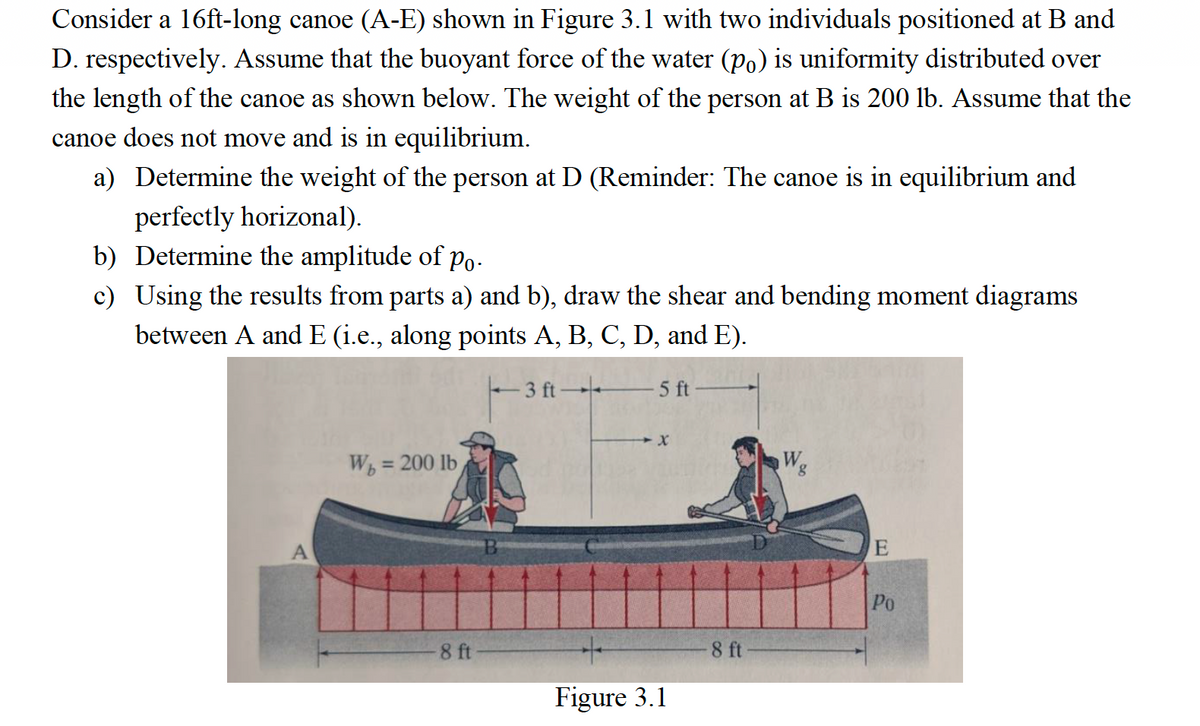Consider a 16ft-long canoe (A-E) shown in Figure 3.1 with two individuals positioned at B and D. respectively. Assume that the buoyant force of the water (po) is uniformity distributed over the length of the canoe as shown below. The weight of the person at B is 200 lb. Assume that the canoe does not move and is in equilibrium. a) Determine the weight of the person at D (Reminder: The canoe is in equilibrium and perfectly horizonal). b) Determine the amplitude of po c) Using the results from parts a) and b), draw the shear and bending moment diagrams between A and E (i.e., along points A, B, C, D, and E). 3 ft- 5 ft W₁ = 200 lb W E Po -8 ft 8 ft
Consider a 16ft-long canoe (A-E) shown in Figure 3.1 with two individuals positioned at B and D. respectively. Assume that the buoyant force of the water (po) is uniformity distributed over the length of the canoe as shown below. The weight of the person at B is 200 lb. Assume that the canoe does not move and is in equilibrium. a) Determine the weight of the person at D (Reminder: The canoe is in equilibrium and perfectly horizonal). b) Determine the amplitude of po c) Using the results from parts a) and b), draw the shear and bending moment diagrams between A and E (i.e., along points A, B, C, D, and E). 3 ft- 5 ft W₁ = 200 lb W E Po -8 ft 8 ft
International Edition---engineering Mechanics: Statics, 4th Edition
4th Edition
ISBN:9781305501607
Author:Andrew Pytel And Jaan Kiusalaas
Publisher:Andrew Pytel And Jaan Kiusalaas
Chapter7: Dry Friction
Section: Chapter Questions
Problem 7.35P: The weight of the cylindrical tank is negligible in comparison to the weight of water it contains...
Related questions
Question
Hi, can you please help me with this question and clearly explain your assumptions?

Transcribed Image Text:Consider a 16ft-long canoe (A-E) shown in Figure 3.1 with two individuals positioned at B and
D. respectively. Assume that the buoyant force of the water (po) is uniformity distributed over
the length of the canoe as shown below. The weight of the person at B is 200 lb. Assume that the
canoe does not move and is in equilibrium.
a) Determine the weight of the person at D (Reminder: The canoe is in equilibrium and
perfectly horizonal).
b) Determine the amplitude of Po-
c) Using the results from parts a) and b), draw the shear and bending moment diagrams
between A and E (i.e., along points A, B, C, D, and E).
-3 ft-
W₁ = 200 lb
8 ft
Figure 3.1
5 ft
X
W
g
E
Po
8 ft
Expert Solution
This question has been solved!
Explore an expertly crafted, step-by-step solution for a thorough understanding of key concepts.
This is a popular solution!
Trending now
This is a popular solution!
Step by step
Solved in 3 steps with 1 images

Knowledge Booster
Learn more about
Need a deep-dive on the concept behind this application? Look no further. Learn more about this topic, mechanical-engineering and related others by exploring similar questions and additional content below.Recommended textbooks for you

International Edition---engineering Mechanics: St…
Mechanical Engineering
ISBN:
9781305501607
Author:
Andrew Pytel And Jaan Kiusalaas
Publisher:
CENGAGE L

International Edition---engineering Mechanics: St…
Mechanical Engineering
ISBN:
9781305501607
Author:
Andrew Pytel And Jaan Kiusalaas
Publisher:
CENGAGE L